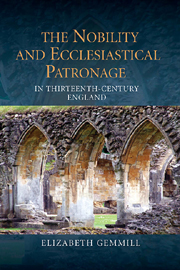Conclusion
Published online by Cambridge University Press: 05 May 2013
Summary
We cannot, then, look at endowment of the Church without also considering what was being taken back and which rights were being defended and nurtured. This, after all, was what patronage was all about. What emerges too is that patronage was a dynamic thing, always needing to be exercised in order to be a reality, and always benefiting from refreshment in the form of new endowments.
Studies of ecclesiastical patronage have tended hitherto to focus on particular families or regions, or to address long time periods. The present study is different because it has focused on a larger, but still discrete, social group, and has examined patronage rights in the special and very important political circumstances of the later thirteenth century. This has made it possible to combine the evidence from a variety of sources to give depth and context to our understanding of the nature of patronage and how it operated. This brief conclusion draws together the main points and suggests where further study would be fruitful.
Until the middle years of the century, advowson rights, unless they were actually granted out (nearly always to an ecclesiastical institution), usually descended with land. They were not normally severed from estates as a consequence of estate transfer. The same is broadly true of patronage rights in religious houses, although with respect to these there was a tendency for upward mobility, with rights sometimes being acquired by overlords, especially when estates were divided up. But from the later years of Henry III's reign, the necessary attachment of patronage to land was being questioned as never before.
- Type
- Chapter
- Information
- Publisher: Boydell & BrewerPrint publication year: 2013



